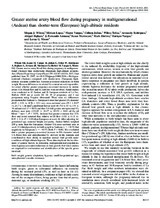Mostrar el registro sencillo del ítem
Greater uterine artery blood flow during pregnancy in multigenerational (Andean) than shorter-term (European) high-altitude residents
| dc.contributor.author | Wilson, Megan J | |
| dc.contributor.author | López, Miriam | |
| dc.contributor.author | Vargas, Marco | |
| dc.contributor.author | Julian, Colleen Glyde | |
| dc.contributor.author | Téllez, Wilma | |
| dc.contributor.author | Rodríguez, Armando | |
| dc.contributor.author | Bigham, Abigail | |
| dc.contributor.author | Armaza, J Fernando | |
| dc.contributor.author | Niermeyer, Susan | |
| dc.contributor.author | Shriver, Mark | |
| dc.contributor.author | Vargas, Enrique | |
| dc.contributor.author | Moore, Lorna G | |
| dc.date.accessioned | 2016-10-24T13:56:37Z | |
| dc.date.available | 2016-10-24T13:56:37Z | |
| dc.date.issued | 2007 | |
| dc.identifier.uri | http://repositorio.umsa.bo/xmlui/handle/123456789/8572 | |
| dc.description.abstract | Multigenerational (Andean) compared with shorter-term (European) high-altitude residents exhibit less hypoxia-associated reductions in birth weight. Because differences in arterial O2 content are not responsible, we asked whether greater pregnancy-associated increases in uterine artery (UA) blood flow and O2 delivery were involved. Serial studies were conducted in 42 Andean and 26 European residents of La Paz, Bolivia (3600 m) at weeks 20, 30, 36 of pregnancy and 4 mo postpartum using Doppler ultrasound. There were no differences postpartum but Andean vs. European women had greater UA diameter (0.65+- 0.01 vs. 0.56 +- 0.01 cm), cross-sectional area (33.1 +- 0.97 vs. 24.7 +- 1.18 mm2), and blood flow at week ... | es_ES |
| dc.language.iso | en | es_ES |
| dc.publisher | Am J Physiol Regul Integr Comp Physiol | es_ES |
| dc.subject | PESO AL NACER | es_ES |
| dc.subject | ADAPTACIÓN GENÉTICA | es_ES |
| dc.subject | HIPOXIA | es_ES |
| dc.subject | RESISTENCIA UTEROPLACENTAL VASCULAR | es_ES |
| dc.title | Greater uterine artery blood flow during pregnancy in multigenerational (Andean) than shorter-term (European) high-altitude residents | es_ES |
| dc.type | Article | es_ES |

